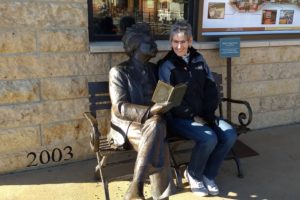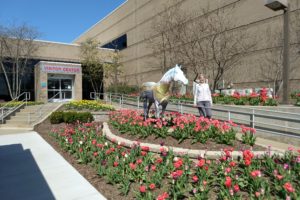Mesa Verde National Park came onto our radar because our youngest son, Matt, and his family stopped here a couple of years ago on their way from California to see us in Georgia and couldn’t stop talking about it. So of course we had to spend some time here to see what they saw.

This park is just outside of Cortez, Colorado. It covers 52,000 acres and protects nearly 5000 archeological sites, including nearly 600 cliff dwellings. What I’m realizing about these parks is that each one has a special purpose to protect something special in that area. I had never thought about it before.
This park is protecting the communities that first were built on top of the mesas. Later on the Pueblo people built in the alcoves beneath the overhanging cliffs. I know you’re asking “why” and “how did they actually get to these later homes.” These were our questions too, and we found some answers that we’ll be sharing in these posts.

First we had to get settled in the campground. All the full hook-up sites were taken, so we were on our own for water and power (thank goodness for a battery, a generator, and being self-contained).


See the pointed hill behind the RV? It’s the only one in the park so we always knew where our campground was. Wonder why there was only 1 triangular hill here.

We initially read in the AAA book that this park highlights the cliff dwelling people from about 2000 years ago, but since that’s about all we knew, we decided to go to the visitors center and see what they had for us.

If you’re like me, when learning something new, I have to have a framework that I can plug details into. Consider this post as the framework, because we’re going to be getting into more depth with real pictures rather than signs we’ll be seeing as we walk through the visitors center.
About 1500 years ago, a group of people in the Four Corners region chose to come here and make their home. Archeologists refer to them as Anasazi, from a Navajo word sometimes translated as “the ancient ones.” Park rangers call them Ancestral Pueblo people.



corn and the Pueblo people

Early Ancestral Pueblo people also farmed beans and squash, as well as hunted and gathered food from around them. Corn still plays an important role in ceremonies, art, and dance of their descendants.

Looks like nomadic hunters from Mexico traveled with corn seeds and planted them in moist areas as they hunted. Later they returned and looked for their harvest and figured it would be a good place to settle.
We did find out that Pueblo people used a dry-farming process. They planted during the raining season and counted on the weather to bring rain during the season so crops would grow. We often use a wet-farming process dependent on irrigation and watering.
their green table


Evidence of farming terraces is found on steep, south-facing hillsides just below the mesa tops. The soils here are deep, temperatures more moderate, and moisture greater than the lower slopes or canyon bottoms. In fact canyon bottoms may seem like good farming locations, but temperature extremes make agriculture difficult. At night cold air from the mesa tops settles in the canyons, while extreme day-time heat bakes both plants and animals.

alcove living

Perhaps they moved for security, or perhaps it was for better shelter from the winter’s cold, the monsoon storms that came in the summer, and the summer heat. Since the cliff dwellings were built in the sandstone, the builders could chip and shape the stone into blocks for living spaces, plazas for public gatherings, and storage.


We know about these pots, ladles, and mugs because everything the Pueblo people didn’t want, they threw over the edge of the cliffs to their garbage dump.


Pots that are soot-blackened were used for cooking. Foods boiled included roots, berries, wild fruits, vegetables, soups, stews, and broth. Other vessels would have been used for storage. Around A.D. 1000, potters began making vessels in the shape similar to our mugs. These mug shapes are distinctive of the Mesa Verde region.

resourceful people


preserving Mesa Verde

Between 1888 and 1891, they made numerous trips on horseback as guides for visitors who wanted to see the sites.

Taking these pieces prompted our Antiquities Act of 1906 that forbid such actions. But he did provide the first systematic examination and photographic record of Mesa Verde’s cliff dwellings.
CCC – again!
Just like the other national parks, the Civilian Conservation Corps (CCC) helped build Mesa Verde in the 1930s.


As we left the visitors center, we were greeted with this beautiful view.

Tomorrow we get to start exploring, but tonight we went to a ranger talk on the animals big and small in the park.





